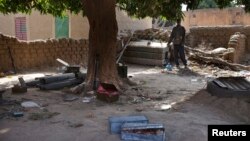GENEVA, SWITZERLAND —
The U.N. Children's Fund is warning that leftover munitions in Mali are threatening the civilian population, especially children. UNICEF says central and northern Mali are most heavily contaminated by unexploded remnants of war.
The U.N. Children's Fund reports 60 people have been victims of explosive remnants of war - two-thirds of them children - during the past 11 months. Five children and two adults have been killed.
UNICEF spokeswoman Marixie Mercado notes these are only preliminary figures, however, and says the actual number of people killed and maimed by these weapons is presumed to be much higher. UNICEF estimated in December at least 100,000 children and parents were at risk in Mali.
"This estimate was made before the military intervention, which has involved air strikes and ground operations since January. We now estimate that approximately 200,000 children in conflict-affected areas of central and northern Mali are now at risk of injury or death due to explosive remnants of war," said Mercado.
French forces invaded northern Mali in January to help oust Islamist militants from the region's major cities and towns. Thousands of soldiers from African countries have since deployed to help keep the rebels at bay. France has indicated it will begin withdrawing its troops from the area next month.
The U.N. Mine Action Service reports large quantities of explosive remnants of war have been left behind.
UNMAS acting senior liaison officer in Geneva, Gustavo Laurie, said the remnants include unexploded and abandoned ammunition, such as artillery shells, mortars, rockets, grenades, bullets, and aircraft bombs.
He said the highest concentration of these weapons is likely to be found in Diabaly, Douentza, Konna and Gao.
"Since January this year, we are established in Bamako in order to ensure coordination of all actors involved in mine action. Mine action involves mine risk education. And, also involves the final disposal of the explosive remnants of war," he said.
Laurie said deployment for emergency clearance has begun in the city of Konna in central Mali, and that other places will follow.
UNICEF says children are particularly vulnerable to unexploded ordnance, because grenades and other devices look like toys and the children pick them up.
To protect civilians from the explosive threat, UNICEF and its partners are planning to step up mine-risk education activities, including life-saving radio messages in five languages. The campaign primarily aims to make 400,000 people aware of the risks who are living in conflict-affected areas of Northern Mali.
The U.N. Children's Fund reports 60 people have been victims of explosive remnants of war - two-thirds of them children - during the past 11 months. Five children and two adults have been killed.
UNICEF spokeswoman Marixie Mercado notes these are only preliminary figures, however, and says the actual number of people killed and maimed by these weapons is presumed to be much higher. UNICEF estimated in December at least 100,000 children and parents were at risk in Mali.
"This estimate was made before the military intervention, which has involved air strikes and ground operations since January. We now estimate that approximately 200,000 children in conflict-affected areas of central and northern Mali are now at risk of injury or death due to explosive remnants of war," said Mercado.
French forces invaded northern Mali in January to help oust Islamist militants from the region's major cities and towns. Thousands of soldiers from African countries have since deployed to help keep the rebels at bay. France has indicated it will begin withdrawing its troops from the area next month.
The U.N. Mine Action Service reports large quantities of explosive remnants of war have been left behind.
UNMAS acting senior liaison officer in Geneva, Gustavo Laurie, said the remnants include unexploded and abandoned ammunition, such as artillery shells, mortars, rockets, grenades, bullets, and aircraft bombs.
He said the highest concentration of these weapons is likely to be found in Diabaly, Douentza, Konna and Gao.
"Since January this year, we are established in Bamako in order to ensure coordination of all actors involved in mine action. Mine action involves mine risk education. And, also involves the final disposal of the explosive remnants of war," he said.
Laurie said deployment for emergency clearance has begun in the city of Konna in central Mali, and that other places will follow.
UNICEF says children are particularly vulnerable to unexploded ordnance, because grenades and other devices look like toys and the children pick them up.
To protect civilians from the explosive threat, UNICEF and its partners are planning to step up mine-risk education activities, including life-saving radio messages in five languages. The campaign primarily aims to make 400,000 people aware of the risks who are living in conflict-affected areas of Northern Mali.











